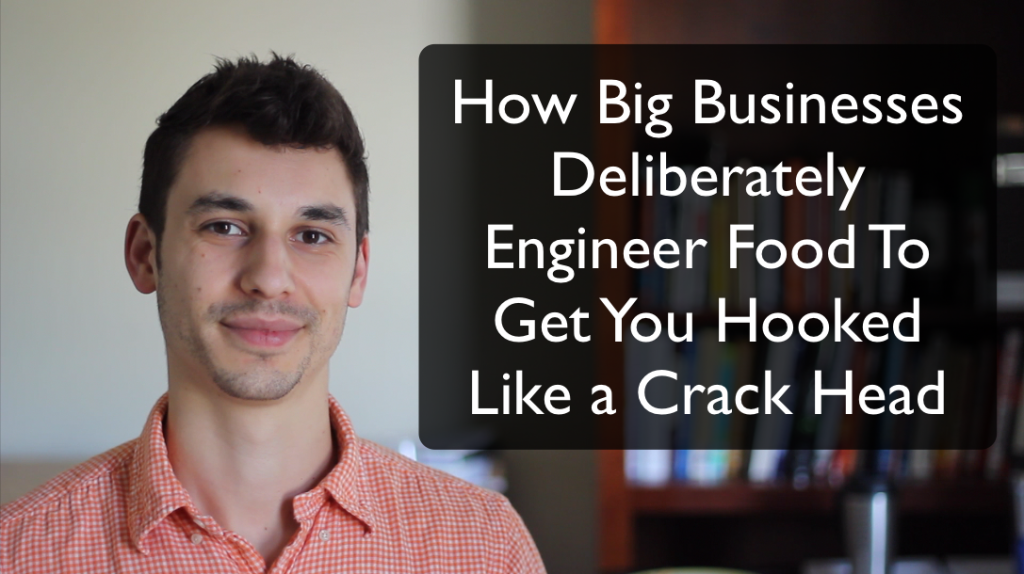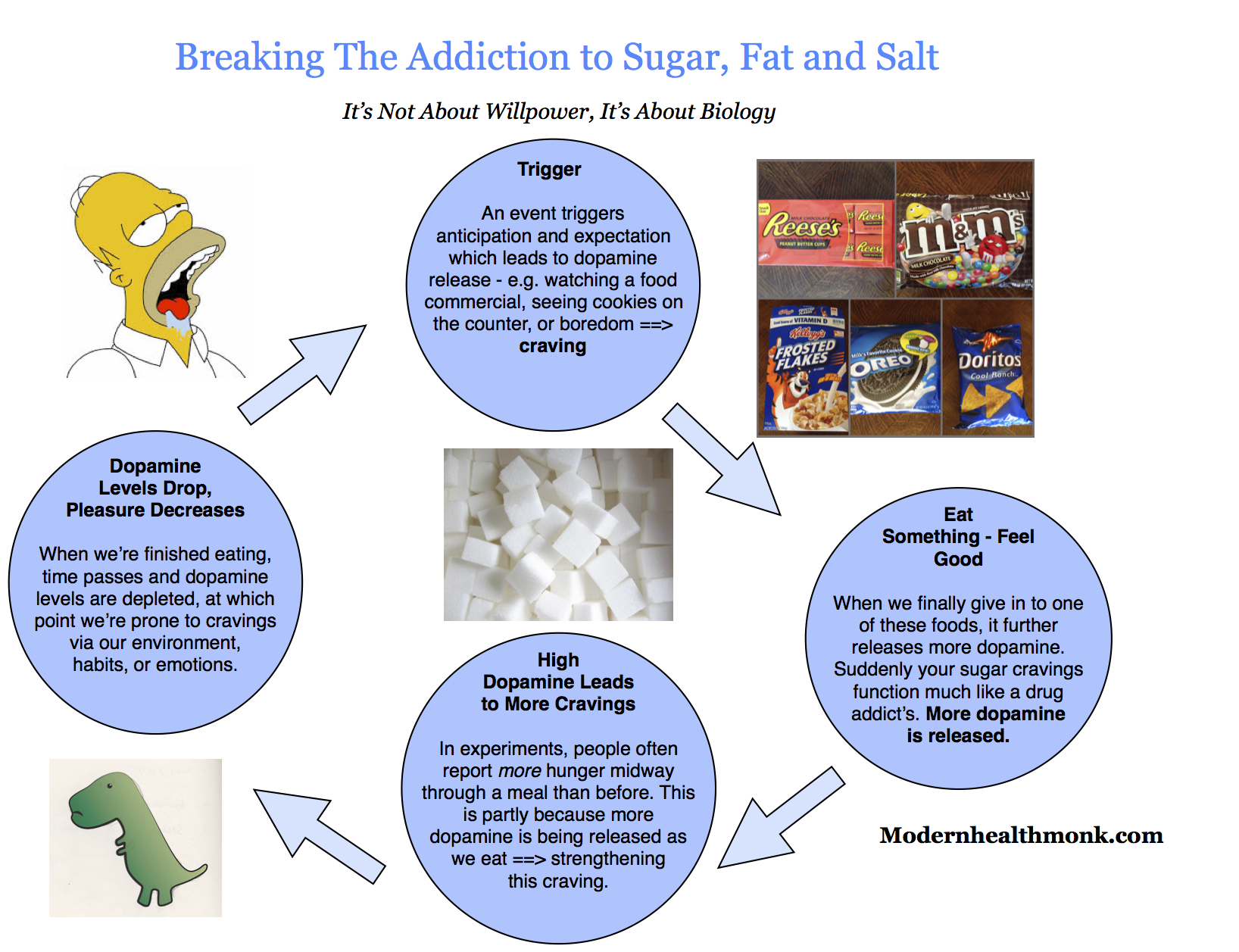
Here’s an Insider Look at How Food is Deliberately Engineered By Scientists to Make it More Addictive
 This might make you a bit sick.
This might make you a bit sick.
Big food companies actually do experiments and pay scientists to figure out how to make food more addictive.
They know what to add, in what quantities, and with with ingredients, to turn us all into crack heads fiending for their own unique flavors of chips, sauces, and desserts.
And they do this in a few main ways.
Some of the studies below might scare you, but once you know how they try to sucker you in, it’s pretty easy to avoid them.
Here’s What Researchers Found is MOST Addictive (& What Food Companies Use)
The food industry has cleverly exploited three things that haywire our biology: Sugar, Fat and Salt.
These three things take advantage of the reward system of the brain which, when triggered, stimulates us to keep eating – and eating – and eating – and eating.
In one study, a researcher added various amounts of sugar to five different dairy products – skim milk, whole milk, half and half, heavy cream, and heavy cream with safflower oil. The point of the various dairy products was that they each had varying levels of fat. Skim milk had almost no fat, while cream and oil contained more than 50% fat.
When people were asked to rate the ones they liked the best, low marks went to the sweetened skim milk (high sugar, low fat), and to unsweetened cream (high fat, low sugar). But when you mix the same amount of sugar into low-fat and high fat products, people prefer the higher fat mix with high sugar.
In other words, it wasn’t just fat or sugar. It was fat and sugar that was addictive.
***
In another study, researchers bred one strain of rats to overfeed when a high calorie diet was present, producing a rat prone to obesity. The other strain did not usually overfeed – an obesity resistant rat. The second group of rats naturally cut back their food consumption quicker than the obesity-primed rats.
But when both groups of rats were offered a creamy liquid that was high in sugar and fat, all of the animals ate without restraint.
Interestingly, increasing only the fat content of the rat’s diet won’t make the animal over eat or become obese. It’s the combination with sugar that makes it overeat.
***
A third study, done in humans, kept male subjects in a ward where their food intake could be measured. For the first few days they were fed a diet designed to keep them at their current body weight (which was around 3,000 calories since they were already overweight). They were given a diet that was 50% carb, 30% fat, and 20% protein.
The participants were then allowed to eat whatever they wished from two free vending machines that contained a variety of things like meats, cheese, bread, cereals, pastries, desserts, french fries, etc. The men were asked to follow their typical eating patterns as closely as possible.
Given the opportunity to eat without restriction, the participants ended up eating an average of 4,500 calories a day. One guy ate almost 7,000 calories. Not only did they over-eat, something interesting happened to their food ratios: they ate a lot more fat (usually coupled with sugar) and less protein. Their fat intake increased to 40 percent, and protein intake decreased to 12 percent.
These three studies are basically the long way of saying something that science knows quite well: given access to high-sugar, high-fat, high-salt foods, many of us will eat them in excessive amounts.
#boomshakalaka
Overeating is Not Your Fault: How the Food Industry Makes You Eat More Than You Think
There are a few main ways that smart food marketers are having you eat a lot more than you think:
- Processing
- Hidden Sugar, Fat & Salt
- Added Chemicals and Flavors
Processing is one of the ways that the food industry sneakily makes you eat more.
Processing basically removes the bran, husk, shell, fiber, and some other things in your food – making it easier to eat a lot more and a lot quicker. It’s baby food for adults.
Boneless wings? So you can scarf em down.
Deep fried anything? The water content is replaced with fat ==> Creating that crispiness you like so much, and a much stronger flavor.
Buttery, creamy rolls and sauces? Fat helps bring out the flavor, and also gives that soft “melt in your mouth” texture.
Hidden sugar and fat is another way that virtually all the big food companies have secretly made your food more addictive, as well as more fattening.
Apple sauce, breakfast cereal, even pasta sauce all have added sugar.
Virtually any sauce or dressing you like has added sugar and fat. Why do kids only like ranch dressing so much? It’s sweet.
Things that originally have a high water content (like veggies or chicken wings) are fried which removes the water and replaces them with fat. If you get wings in a restaurant, they’ve probably actually been fried 2-3 times. One at the factory, and multiple times at the restaurant.
Consumers even started getting smart and avoiding the word “sugar” on labels – so companies started putting in 4-5 different types of sugar – honey, molasses, high-fructose corn syrup – so that sugar could get pushed further down on the ingredient list.
Some breads even have a lot of sugar – McDonald’s hamburger buns are on a sweetness level of 7 out of 15.
Ketchup is around an 8 or 9, while Pizza Hut pizza sauce is close to a 10 or 12 out of 15.
Added sugar is everywhere – and not just in your frosted flakes.
Apple sauce, breakfast foods, your morning orange juice that is slowly killing you, you name it – added sugar.
Added chemicals and flavors are another way to create flavors and get you hooked.
Hot chocolate, for example, has almost no chocolate in it. It’s a high school science experiment. If that terrifies you, it should. It’s basically made up of some dairy replacements (for that creamy quality) and then has added sugar and artificial flavors.
There are billion dollar businesses designed to make food taste like something that it’s not.
So instead of including dairy products in your food, the artificial flavoring companies can remove that and just make it taste like there’s dairy in there.
How to Break the Cycle: It’s Not About Willpower – It’s About Biology
I want you to repeat this sentence over and over: It’s not about willpower, it’s about biology.
Ultimately, breaking free from the addiction to sugar, fat [ the bad kind, not the good kind ] and salt lies in one thing: not eating them. But how?
When we sit around triggers or cues – we begin to crave these foods, the craving releases dopamine, which then gets us to eat the food, which releases more dopamine.
Willpower is useless here – it would be like telling a drug addict to just “fight” the heroin craving. Instead, start thinking about how you can set up systems that prevent you from failing.
The vast majority of people passing on this stupid “willpower” advice are people who have no direct experience dealing with anything remotely related to what you are dealing with. It’s just a stupid piece of blanket advice that hasn’t been street-tested.
Here are 3 systems that will help you kick the addiction for good. Remember, I’m not going to give you some “willpower” BS or “just do it” crap advice.
The 3 Systems:
- Awareness
- Habit Re-Training
- Food Rehab
I’ve talked about these ad nauseum before like in the following articles, so I won’t repeat myself:
- Why All Diets Fail – Habits 101
- 5 Jedi Mind Tricks to Overcome Emotional Eating & Food Addiction
- Are You Suffering From The Biggest Problem in Nutrition and Dieting?
So What Now? The Recap

There are a few things I want you to remember here, the 5 key takeaways behind this whole thing.
- Food is a big business. There are millions of dollars spent finding out how to get you to eat more of someone else’s product.
- Food addiction functions almost identically to a drug addiction, affecting the opioid receptors of the brain – the reward system.It’s a joke to try and tell someone to “just use willpower” and fight a food addiction or try and diet. If I catch you giving that advice I’m going to slap you with a wet fish! Just kidding

- To beat food addictions, you ultimately need to go cold turkey and totally cut yourself off – the trick is how. You probably already knew that – the what – the how is much harder, and that’s what I hope this article helped you do.
- To go cold turkey and get off of addicting foods, use three main systems: A. Awareness, B. Habit Re-Training, and C. Food Rehab. When you learn the triggers and cue associated with food or sugar cravings, you already are one step closer to controlling them.
- When you no longer eat sweets and addictive foods, your sweet tooth goes away. It’s true! Like drugs, you will stop craving them the less you eat them.
“Just Use Willpower” Is the Dumbest Piece of Advice To Give Someone
I think we need to start a movement discouraging the “just use willpower and discipline” approach. Why? For starters? It doesn’t work.
Second, it’s usually the people who don’t have experience giving the advice: “Oh, you just don’t have any willpower.”
Would you tell a drug addict, “Oh just fight the cravings man! You just need to be stronger!” No, of course not.
The addiction to sweets and foods is real and biological. We’re also going up against companies that still are finding ways to make food more addictive, even in the middle of an obesity epidemic.
I hope this will open your eyes a little bit as to what really goes on when you get cravings (for sugar, fat, salt, or anything else), and why, and most importantly – how to beat them.
Try it and let me know how it goes –
– Alex

This was SO shocking and disgusting. Fortunately, we neither buy nor eat any of the problem foods you mentioned : ). I just visualize all the fat settling into a part of my body where I don’t want any fat and that’s enough to keep me away. (Yuck.) Same w/sugar, sodium, and all other noxious substances.
GREAT blog! Keep up the great work
Thanks Annie 🙂 Haha and I love your visualization! That’ll do it.
It’s tough to avoid them if buying packaged stuff, but if we cook it’s pretty easy!